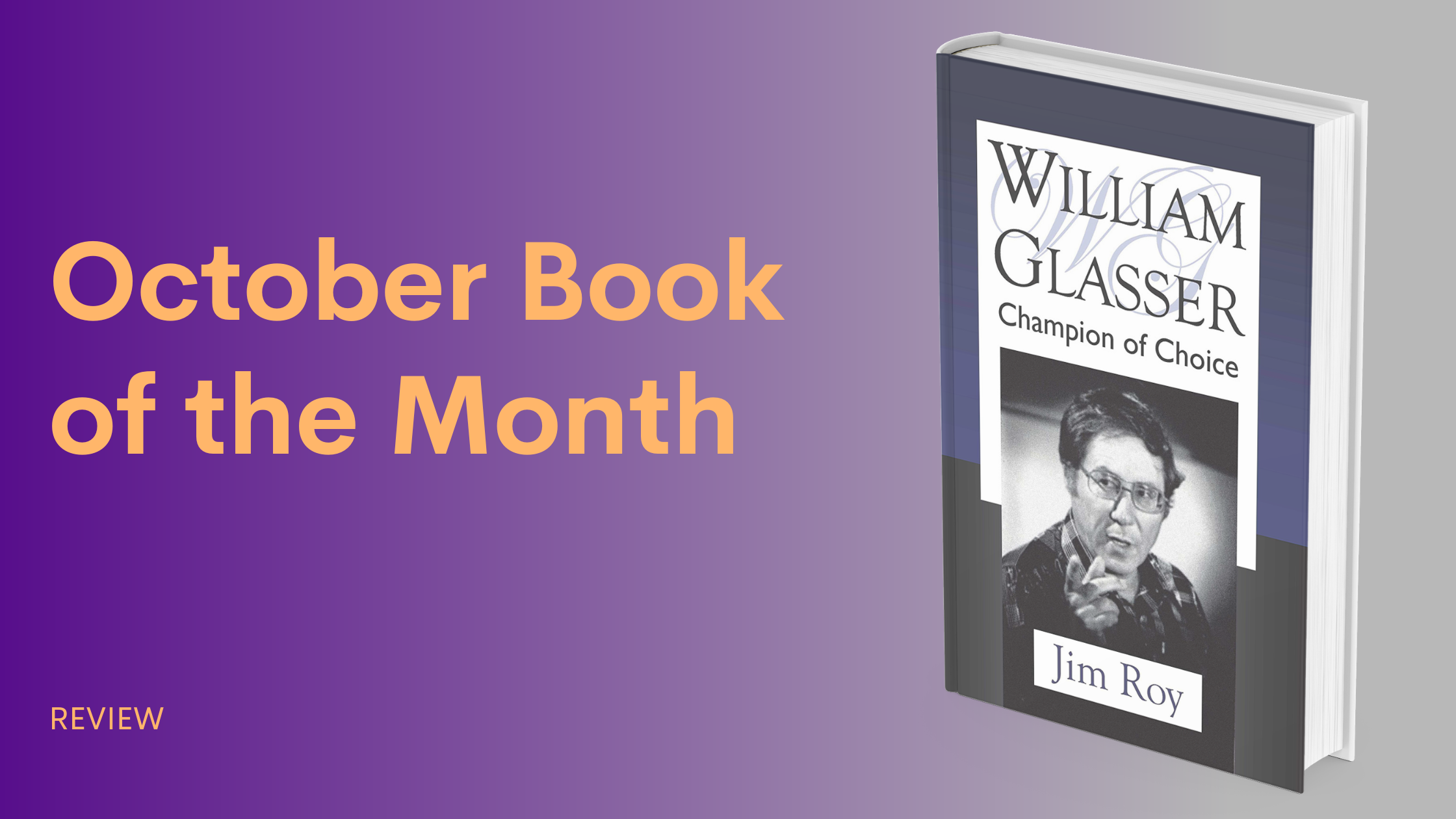October Book of the Month
William Glasser: Champion of Choice by Jim Roy (Zeig, Tucker & Theisen, 2014)
Jim Roy’s Champion of Choice brings William Glasser’s path vividly to life, tracing how one psychiatrist’s lifelong tendency to question authority reshaped therapy and education. From his Depression-era Cleveland beginnings to his challenge of psychiatry’s medical model, Glasser kept revising his own assumptions in light of experience. During his career he built an international network of institutes, workshops, and conferences that carried his ideas into schools, clinics, and counseling rooms around the world.
Roy’s biography blends story and scholarship, showing how personal conviction, cultural upheaval, and clinical innovation combined to produce a model that was strikingly relevant.
Ideas made in practice
Roy writes so one can watch the core practices of Reality Therapy take shape: building genuine involvement, focusing on what the person is doing now, inviting honest self-evaluation, and asking for a concrete next step to carry forward. What begins as a set of practical strategies becomes a framework in Glasser’s book Reality Therapy (1965). Over time he refines the model by organizing motivation around five basic needs—survival, love and belonging, power, freedom, and fun—and describing total behavior as doing, thinking, feeling, and physiology, with change most possible through doing and thinking. His model comes alive when a client identifies an unmet need, chooses a better response, and carries that choice into daily life. By the mid-1990s, Glasser renames his framework Choice Theory, emphasizing self-management over external control.
The human center
Roy is deliberate in showing how life experience shaped Glasser’s clinical values.
Example: At one point early in his career, Glasser questions a dress code that required psychiatrists to wear white lab coats like medical doctors. For him the coat symbolized distance and authority, a barrier that reinforced hierarchy. Refusing it became a way for Glasser to signal partnership to patients instead of domination.
Glasser’s drive to work together instead of asserting power grew out of his own family experience. Raised by a mother whose strong will often turned controlling, Glasser learned early the costs of coercion and resolved not to repeat the pattern. The same principle shows up in his theory: an emphasis on personal agency and a rejection of techniques that impose from the outside.
The times that shaped the theory
Roy also situates Glasser’s work within the social forces that shaped mid-century psychiatry. Glasser begins his residency just as Thorazine transforms treatment and defines a new medicalized era that he would later resist. The turbulence of the 1960s, including the civil rights movement, student unrest, and the growing language of personal freedom, parallels his emphasis on choice and responsibility. Glasser’s rejection of external control and insistence on personal agency reflected both the cultural mood of autonomy and a psychological alternative to conformity.
Why this book now
It models adaptable practice. Glasser revises in public when results and new understandings show a better way, moving from Reality Therapy to Control Theory to Choice Theory. He also adjusts his views as society evolves…recognizing, for instance, that schizophrenia required a more nuanced view than his early stance allowed. For clinicians today, his example underscores the value of being willing to reevaluate the work when both outcomes and cultural understanding call for change.
It reconnects theory to the room. The five basic needs and the concept of total behavior translate directly into what therapists can ask in supervision, what they can listen for in session, and what they can assign for practice between meetings. Roy’s account in this book makes the bridge between big ideas and daily practice unusually clear.
It restores hope. The Ventura School chapter demonstrates that environments matter. When punishment was replaced by accountability and credit was linked to completed work, girls who had long expected failure began to succeed. The recognition that conditions can be altered, and that change can create new patterns of behavior, resonates strongly here.
It sharpens present debates. In an era still wrestling with the overreach of diagnosis, the quick default to medication, and the tension between personal responsibility and systemic constraint, Glasser’s refusal to reduce people to labels feels timely. Seeing how he revised his thinking in response to both patients and social change gives perspective on our own debates, reminding us that clinical frameworks are always provisional and open to growth.
Ericksonian connections
Both Glasser and Erickson built their work from lived experience, letting what happened in the room shape what came next. Each believed that clients already hold the resources needed for change and that the present moment is where those resources can be used. Erickson called this utilization…meeting clients within their own language, behavior, and context to spark movement. Glasser called it choice…helping clients recognize how much control they have in shaping their current actions and responses. In both views, change begins when the therapist joins the client’s reality and helps turn awareness into agency and empowerment. Their two ideas are united in a belief that flexibility, creativity, and relationship make the soil in which new behavior takes root.
Final thought
Roy’s book reminds us that theories are not built in a vacuum. They grow out of real encounters with patients, with institutions, and within a changing world. Glasser’s story models what it means to stay curious in practice: to keep listening, adjusting, and shaping one’s work around what truly helps.
You may like …






